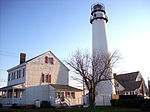Fenwick Island (Delaware–Maryland)
Barrier islands of DelawareBarrier islands of MarylandDelaware geography stubsFenwick Island (Delaware–Maryland)Islands of Maryland ... and 4 more
Landforms of Sussex County, DelawareLandforms of Worcester County, MarylandSalisbury metropolitan area, Maryland geography stubsSpits of the United States

Fenwick Island is a barrier island along the Atlantic Ocean in Delaware and Maryland in the United States. It contains the communities of South Bethany and Fenwick Island in Delaware along with Ocean City, Maryland. Until 1933, it was attached to Assateague Island to the south. That year, a hurricane carved an inlet between the two landforms, which was made permanent. If not for the Assawoman Canal, constructed by the U.S. Army Corps of Engineers in 1891, the island would be attached to the mainland of Delaware.
Excerpt from the Wikipedia article Fenwick Island (Delaware–Maryland) (License: CC BY-SA 3.0, Authors, Images).Fenwick Island (Delaware–Maryland)
Bunting Avenue,
Geographical coordinates (GPS) Address Nearby Places Show on map
Geographical coordinates (GPS)
| Latitude | Longitude |
|---|---|
| N 38.453333333333 ° | E -75.048333333333 ° |
Address
Bunting Avenue 38893
19944
Delaware, United States
Open on Google Maps





